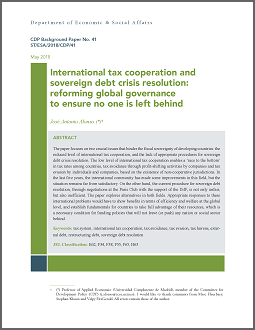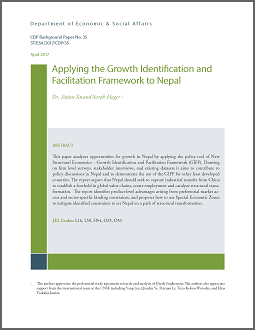Document_CDP: CDP Background Paper series
CDP Background Paper series
17 May 2018
The paper focuses on two crucial issues that hinder the fiscal sovereignty of developing countries: the reduced level of international tax cooperation, and the lack of appropriate procedures for sovereign debt crisis resolution. The low level of international tax cooperation enables a ‘race to the bottom’ in tax rates among countries, tax avoidance through profit-shifting activities by companies and tax evasion by individuals and companies, based on the existence of non-cooperative jurisdictions.
9 April 2018
The paper examines whether the planned eradication of poverty to the year 2030 part of the SDG strategy is compatible with the expected trends in key economic variables such as GDP growth, population growth, income inequality and food prices.
26 March 2018
This paper presents some of the challenges of the “leaving no-one behind” mandate. Firstly, how the development cooperation system can be brought up to date; secondly, why cooperation may still be useful and effective in supporting an Agenda beyond ODA; and finally, the way in which resources should be allocated in order to preserve the purpose of development cooperation.
9 February 2018
Strengthened intellectual property requirements, government procurement, dispute settlement constrain policy space for implementing universal health coverage. These consequences can have particularly dramatic effects for countries that made effective use of medicines and intellectual property policies to expand access to medicines.
2 February 2018
CDP Background Paper No. 37 By Committee for Development Policy secretariat Least developed countries (LDCs) are characterized by limited productive capacities, which constrains their efforts towards structural transformation and sustainable developmen ...
10 May 2017
CDP Background Paper No. 36 By Daniel Gay The United Nations Committee for Development Policy (CDP) comprises 24 independent specialists from a variety of disciplines. It advises the UN Economic and Social Council on emerging economic, social and envir ...
10 May 2017
CDP Background Paper No. 35 By Dr. Jiajun Xu and Sarah Hager This paper analyzes opportunities for growth in Nepal by applying the policy tool of New Structural Economics – Growth Identification and Facilitation Framework (GIFF). Drawing on firm level ...
12 April 2017
The paper starts with an overview of Ethiopia’s economic growth and the change in the domestic economic structure. The manufacturing sector is seen as the success of Ethiopia’s Growth, and its development to a large extent the product of an activist developmental state. The paper then examines growth and diversification of exports and the country’s recent efforts to effectively exploit its natural resources. An analysis of public and private investment and the underlying allocation of financial resources finds that a recent upturn in domestic investment has been financed largely by foreign aid, and that private financing remains too low. Finally, the paper addresses educational attainment, arguing that Ethiopia has some distance to go in its attempts to close the large human capital gap relative to other low-income countries.
11 July 2016
CDP Background Paper No. 33 By Giovanni Andrea Cornia and Antonio Scognamillo The conventional approach to least developed country (LDC) graduation has considered these countries as an undifferentiated group whose problems could be solved by means of s ...










Follow Us